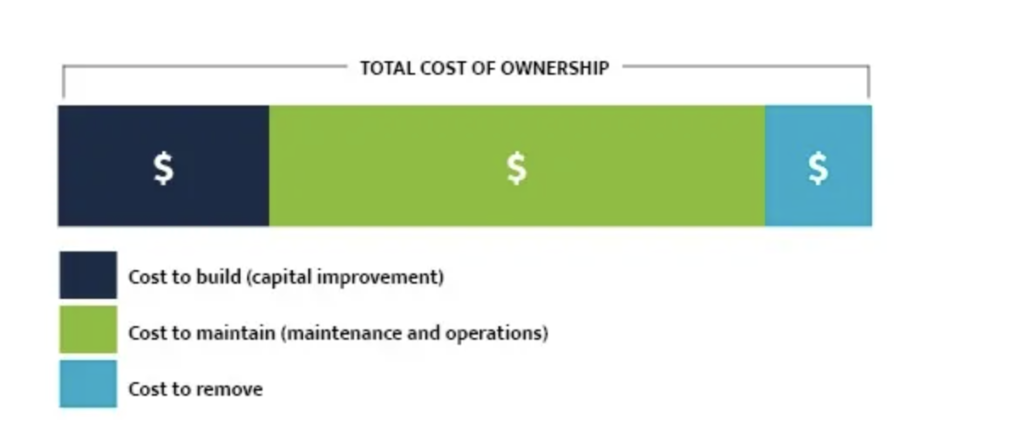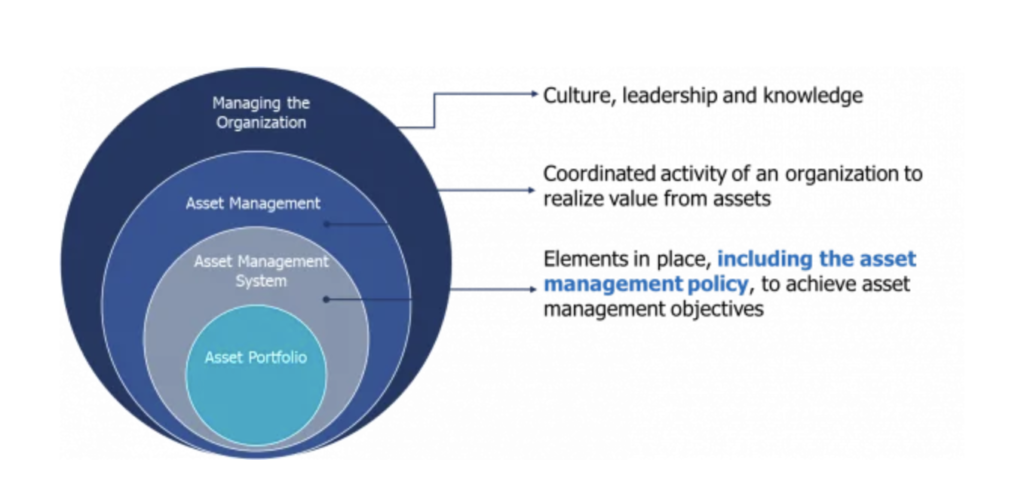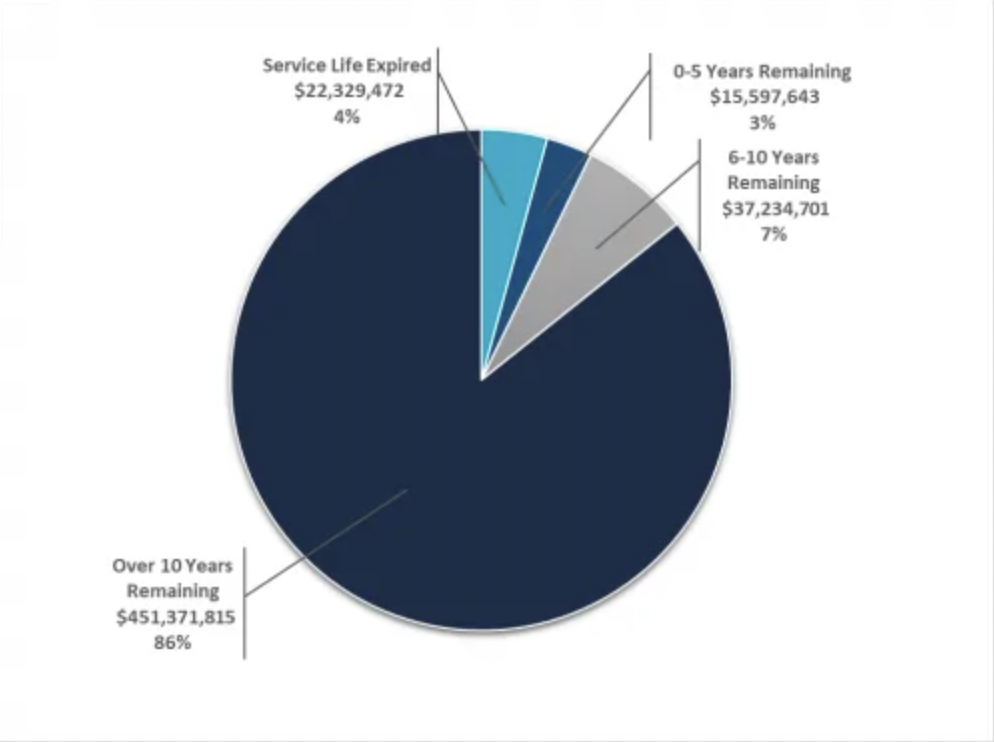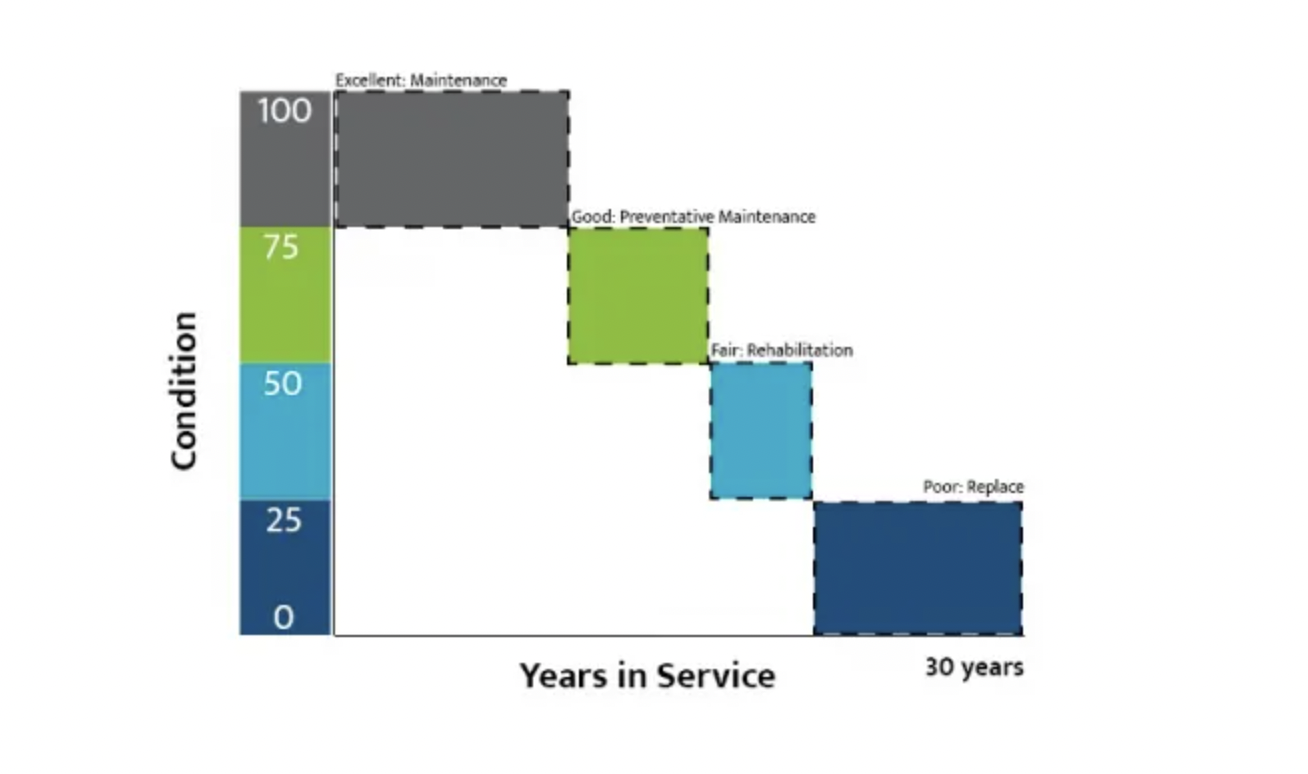Share on
As defined by ISO 55000 – an international benchmark for asset management standards – asset management is the coordinated activity of an organization to realize value from assets. In practice, effective asset management can improve infrastructure decision making at the corporate level, optimize long term capital expenditures, and strengthen the reliability and resiliency of capital assets over time.
Some larger counties and cities in the United States have begun practicing asset management by creating programs or implementing asset management plans. For instance, the County of Los Angeles has its own asset management branch that encompasses capital and maintenance programs to optimize the utilizations of the region’s assets. It is also common that asset management is incorporated within capital improvement programs. The City of Largo, Florida, released its 2021-2025 Capital Improvement Plan, which encourages the utilization of asset management strategies to carry out various community projects related to facilities, recreation, wastewater, and stormwater assets.
In Texas, like most states, asset management is still more generally practiced at the state government level. The Fiscal Management Division of the Texas Government sets out reporting requirements in line with asset management principles; each state agency in Texas is required to report of any assets valued at $500,000 or greater and are encouraged to report all of their capital assets. Even more, state agencies are also required to report on:
More specifically, the Texas Department of Transportation has a comprehensive asset management plan comprised of an asset inventory, performance and condition assessments, lifecycle planning, risk management, and financial strategies. Likewise, the Texas Commission on Environmental Quality (TCEQ) has guidelines specific to water and wastewater asset management. TCEQ’s approach to water and wastewater asset management includes four steps:
Despite no legislation or regulations requiring local governments in Texas to practice asset management to manage their infrastructure assets in 2017, Hart was adamant was adamant of the value that asset management would bring to the City and its infrastructure.
The City of Corinth is located in the north-central part of Texas and has a land area of eight square miles. The City, with its 21,000 residents, is a relatively new municipality having incorporated in September of 1960. The City operates under a council-manager form of government.
Because the City of Corinth is a young community, the City is in a favourable position to begin introducing asset management practices. According to Cody Collier, Director of Public Works, the City’s infrastructure is new or in the middle of its expected useful life, which places the City in an advantageous position to begin asset management initiatives. Hart notes that in approximately ten years, the City’s infrastructure will be in need of significant attention. Asset management is fundamental to ensure that infrastructure projects are well coordinated and strategic investment in assets is optimized. According to Hart, “We have to start planning today to be able to respond to our needs long term.”
For local governments, effective asset management ensures infrastructure services are affordable and delivered to the community with minimal disruption and risk. Initial capital expenditures account for only 10-20 percent of an asset’s lifecycle costs, with the remaining 80-90 percent attributed to its ongoing operation and maintenance. Asset management is the process of minimizing these lifecycle costs while extracting the highest value from the asset portfolio.
Through an iterative process, asset management optimizes local government budgets by identifying the proper balance between which infrastructure services are desired by the community and the willingness and ability of residents to pay for them. In this way, expenditures on infrastructure are prioritized and aligned with council’s overall strategic vision for the community.

Figure 1. Total Cost of Ownership of Assets

Figure 2. Components of Holistic Asset Management
Council buy-in is essential for securing a long-term commitment to asset management. Hart explained that buy-in was achieved in part by demonstrating that council’s philosophy aligned with the principles of asset management. He noted that council’s “forward-thinking” mindset – emphasizing being proactive to address future challenges for the City of Corinth – allowed for asset management to be presented as a strategic tool for forecasting and planning future infrastructure actions.
The first step in introducing asset management to the City of Corinth was creating an Asset Management Team (AMT), with an initial objective of learning the principles and components of an effective asset management program. Hart noted that asset management training for the AMT was an essential first step to ensure that the AMT members would become asset management stewards for the City. The AMT were trained in asset management through the Institute of Public Works Engineering Australasia (IPWEA). Prior to working with PSD to create the City’s Asset Management Plan (AMP), Corinth also received training from PSD’s team of experts, learning and familiarizing the team with North American best practices of asset management.
The City of Corinth’s AMT is cross-departmental, in line with a core principle of asset management which states that to be effective, asset management should be an enterprise-wide undertaking. The AMT is comprised of the following personnel:
The next step in building an asset management program is defining roles and responsibilities for the asset management team and ensuring that an effective governance framework is in place. An Asset Management Policy is used to document the chosen governance framework. In December of 2018, Corinth Council passed its first Asset Management Policy, further legitimizing the value of asset management at the corporate level. The Policy reads, “the approval of this policy is an important step towards integrating the Municipality’s strategic goals with its asset management program, and ensuring that critical municipal infrastructure assets and vital services are maintained and provided to the community in a consistent, reliable, and sustainable manner.”
Typically included in an asset management policy is a policy statement and purpose, roles and responsibilities, guidelines and key principles, and how asset management aligns with the community’s strategic goals and direction. Most importantly, a policy helps support asset management governance in an organization insofar that the policy becomes a guideline for staff to follow in making decisions and provides a framework for the delegation of decision-making, eliminates misunderstandings, reduces uncertainties, and enables goals and objectives to be met.
Set forth in the City of Corinth’s Asset Management Policy is the creation of an Asset Management Plan (AMP) that includes each of the City’s asset classes. An AMP is a strategic component of asset management for local governments. Corinth worked with PSD to develop their AMP and through collaboration with PSD staff – comprised of engineers, geospatial technicians, and former municipal officials – the City received hands-on support to confirm data was reliable and meaningful and to ensure informed and smart infrastructure decisions are executed.
An AMP provides an overview of the current state of the City’s asset management program, a blueprint for the activities that should be performed and the resources that will be necessary to meet the City’s asset management objectives. Defined in their Policy, the City of Corinth’s asset management objectives include:
Typical of most AMPs, the City of Corinth’s AMP includes a comprehensive State of the Infrastructure Report, asset management strategies, and a financial strategy to meet their infrastructure challenges over the medium- and long-term.
Integral to developing and strengthening the City of Corinth’s asset management program was an assessment of the City’s infrastructure. All capital infrastructure assets are included in the AMP which include the following asset classes:
To create the State of the Infrastructure Report, PSD requested all available data for municipal assets that the City of Corinth had available. The Report includes the City’s full asset inventory, condition ratings, useful life consumption data and the backlog and upcoming infrastructure needs for each asset class. Prior to working with PSD, the AMT had a significant amount of institutional knowledge of asset management and municipal assets had detailed listings paired with GIS data. Upon review of the data provided by the City of Corinth, the asset inventory was up-to-date, detailed, and uniform and was not missing any significant data required to carry out the creation of the AMP. Using a confidence matrix based on several factors, including the age of data, the completeness and uniformity of data, and data reliability, it was determined that the City of Corinth’s data had an overall confidence rating of 98 percent.
The AMP demonstrated that 86 percent of the City of Corinth’s assets have at least 10 years of useful life remaining. Only four percent of assets are operating beyond their established useful life and an additional three percent of assets will reach the end of their useful life within the next five years. Moreover, according to age-based data, only 26 percent of the City’s assets are in poor to very poor condition. By comparison, the Canadian Infrastructure Report Card (2016) reported that 35 percent of municipal assets are in fair, poor and very poor conditions.

Figure 3. Distribution of value of assets by useful life remaining
With a broad snapshot of the state of the City’s infrastructure, the Report outlines each asset category’s average remaining useful life and total replacement cost in greater detail. During the time the AMP was completed, the City’s road system comprised 53 percent of the total infrastructure backlog and replacement needs. While 79 percent of the City’s road system has at least 10 years of useful life remaining, 5 percent remain in operation beyond their useful life. The backlog represents the investment needed today to meet previously deferred replacement needs. The AMP also forecasted investment requirements for the next five years, and subsequent years afterwards, reaching year 2067.
The City of Corinth is in an opportune position to benefit greatly from asset management. The creation and training of an asset management team, the adoption of an Asset Management Policy, and the development of an Asset Management Plan are all measures that will make asset management a sustainable and worthwhile practice for the City.
Central to the development of a local government’s overall asset management maturity is the establishment of an Asset Management Strategy. In the latter part of the AMP, the Asset Management Strategy outlines lifecycle activities for each asset category included in the AMP. Lifecycle activities should be conducted at the appropriate time in an asset’s life, to provide the greatest additional life to the asset at the lowest cost. In other words, doing the right thing to the right asset at the right time. Examples of lifecycle activities include preventative maintenance, rehabilitation, and replacement or reconstruction.
There are different types of lifecycle activities among the different asset classes and choosing the best intervention depends on various factors, including: timelines of deterioration of asset type, costs of maintenance and rehabilitation, functional and legislative requirements, and health and safety concerns, to name a few. In the case of Corinth’s road system – the City’s foremost asset management priority – the type of lifecycle activities chosen are based on the condition of the asset, displayed in the following figure:

Figure 4. Lifecycle activity types by asset condition and years in service
In order for an AMP to be effective, it must be integrated with financial planning and long-term budgeting. The development of a comprehensive financial plan will allow the City to identify the financial resources required for sustainable asset management based on existing asset inventories, desired levels of service, and projected growth requirements.
The City of Corinth’s AMP presented two financial plan options, with the City choosing the plan that encompasses a fifty-fifty funding strategy. For the City of Corinth, the recommended financial strategy to fund tax-funded assets (road system; bridges & culverts; buildings & facilities; and machinery & equipment) is to incrementally increase taxes to support 50 percent of capital expenditures. The original plan was to introduce a .8 percent tax increase each year for the next twenty years (starting in year six). As a result of revenue caps on property tax passed by the Texas Legislature in 2019, funding will be achieved through the issuance of debt.
The other 50 percent of the funding requirement for tax-based assets will be derived from the Asset Management Fund. Passed by council, the City created an Asset Management Fund that receives dedicated funds specific to asset management activities through an allocation of utility and general funds and the occasional sale of assets. Key here is that the only way that funds can be taken out is through council approval. The funding will be introduced in the 2019-20 fiscal year.
Moving forward, and to strengthen the usefulness of the AMP, the City of Corinth will be collecting condition-based data for its assets by acquiring pavement condition analysis software and asset condition software. So far, only six percent of the City’s assets have assessed condition data, with all other asset condition data being age-based.
Age-based data relies on the amortization schedule of an asset and may not be reflective of an asset’s actual condition and the true nature of its deterioration, which tends to accelerate toward the end of the asset’s lifecycle. Assessed condition data helps to better advance the understanding of infrastructure needs, improves budget prioritization methodologies and ensures lifecycle activities are more accurate.
Despite the lack of asset management activity at the local government level in Texas, asset management is slowly becoming more of a concern in Texas and across the nation. Collier noted that the Public Works Institute of Texas (PWITX), the Certified Public Manager Program (CPM) and the American Public Works Association (APWA) are all placing a major focus on asset management capacity building, advocating that communities should prioritize asset management in the face of limited infrastructure funding. At the local government level, asset management is a viable solution and resource as communities continue to struggle with aging infrastructure and tight budgets.
The City of Corinth is in an opportune position to benefit greatly from asset management. The creation and training of an asset management team, the adoption of an Asset Management Policy, and the development of an Asset Management Plan are all measures that will make asset management a sustainable and worthwhile practice for the City. Collier states, “PSD has provided Corinth with a great tool to move forward and build upon to meet the needs of our future growth and fiscal responsibilities.” While other communities continue to make budgeting and asset intervention decisions using outdated and incomplete asset data, and without a coherent corporate-level strategy, Corinth will have tools, resources and direction to optimize decision-making in the long term.